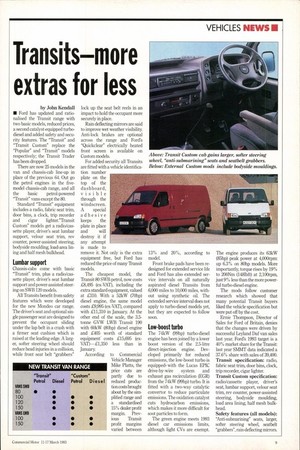Transits more extras for less
Page 11

If you've noticed an error in this article please click here to report it so we can fix it.
by John Kendall • Ford has updated and rationalised the Transit range with two basic models, reduced prices, a second catalyst-equipped turbodiesel and added safety and security features. The "Transit" and "Transit Custom" replace the "Popular" and "Transit" models respectively; the Transit Trader has been dropped.
There are now 25 models in the van and chassis-cab line-up in place of the previous 64. Out go the petrol engines in the fivemodel chassis-cab range, and all the basic petrol-powered "Transit" vans except the 80.
Standard "Transit" equipment includes a radio, fabric seat trim, door bins, a clock, trip recorder and cigar lighter."Transit Custom" models get a radio/cassette player, driver's seat lumbar support, velour seat trim, rev counter, power-assisted steering, bodyside moulding, load-area lining and half mesh bulkhead.
Lumbar support Chassis-cabs come with basic "Transit" trim, plus a radio/cassette player, driver's seat lumbar support and power-assisted steering on SWB 120 models.
All Transits benefit from safety features which were developed for the new Mondeo car range. The driver's seat and optional single passenger seat are designed to prevent the occupant sliding under the lap belt in a crash with a firmer seat cushion which is raised at the leading edge. A larger, softer steering wheel should reduce head injuries in a collision, while front seat belt "grabbers" lock up the seat belt reels in an impact to hold the occupant more securely in place.
Rain deflecting mirrors are said to improve wet weather visibility. Anti-lock brakes are optional across the range and Ford's "Quickclear" electrically heated front screen is available on Custom models.
For added security all Transits are fitted with a vehicle identification number plate on the top of the dashboard, visible through the windscreen. A special adhesive keeps the plate in place and will destroy it if any attempt is made to remove it. Not only is the extra equipment free, but Ford has reduced the price of many Transit models.
The cheapest model, the Transit 80 SWB petrol, now costs £8,495 (ex-VAT), including the extra standard equipment, valued at £310. With a 52kW (70hp) diesel engine, the same model costs £9,995 (ex-VAT), compared with £11,310 in January. At the other end of the scale, the 3.5tonne GVW LWB Transit 190 with 60kW (80hp) diesel engine and £405 worth of standard equipment" costs £15,695 (exVAT)—£1,350 less than in January.
According to Commercial Vehicle Manager Mike Platts, the price cuts are partly due to reduced production costs brought about by the simplified range and a standardised 15% dealer profit margin. Previous Transit profit margins varied between "Custom" Petrol Diesel • • • • • 13% and 20%, according to model.
Front brake pads have been redesigned for extended service life and Ford has also extended service intervals on all naturally aspirated diesel Transits from 6,000 miles to 10,000 miles, without using synthetic oil. The extended service interval does not apply to turbo-diesel models yet, but they are expected to follow soon.
Low-boost turbo The 74kW (99hp) turbo-diesel engine has been joined by a lower boost version of the 2.5-litre direct-injection engine. Developed primarily for reduced emissions, the low-boost turbo is equipped. with the Lucas EPIC drive-by-wire system and exhaust gas recirculation (EGR) from the 74kW (99hp) turbo. It is fitted with a two-way catalytic convertor to reduce particulate emissions. The oxidation catalyst cuts hydrocarbon emissions, which makes it more difficult for soot particles to form.
The green engine meets 1993 diesel car emissions limits, although light CVs are exempt.
The engine produces its 63kW (85hp) peak power at 4,000rpm: up 6.3% on 80hp models. More importantly, torque rises by 19% to 200Nm (1481bft) at 2,100rpm, just 9% less than the more powerful turbo-diesel engine.
The mods follow customer research which showed that many potential Transit buyers liked the vehicle specification but were put off by the cost.
Ernie Thompson, Director of Sales for Ford of Britain, denies that the changes were driven by successful Leyland Daf van sales last year. Ford's 1993 target is a 40% market share for the Transit: last year SMMT data indicated a 37.6% share with sales of 39,400. Transit specification: radio, fabric seat trim, door bins, clock, trip recorder, cigar lighter.
Transit Custom specification: radio/cassette player, driver's seat, lumbar support, velour seat trim, rev counter, power-assisted steering, bodyside moulding, load area lining, half mesh bulkhead.
Safety features (all models): "Anti-submarining" seats, larger, softer steering wheel, seatbelt "grabbers", rain-deflecting mirrors.
















































































